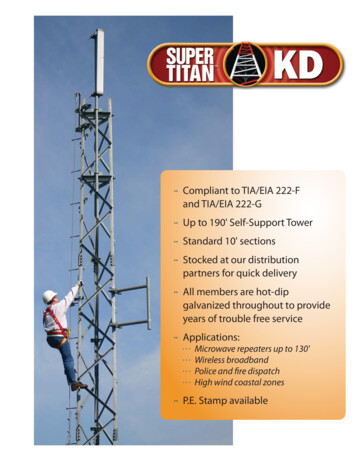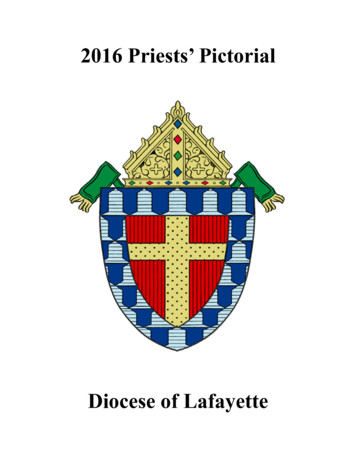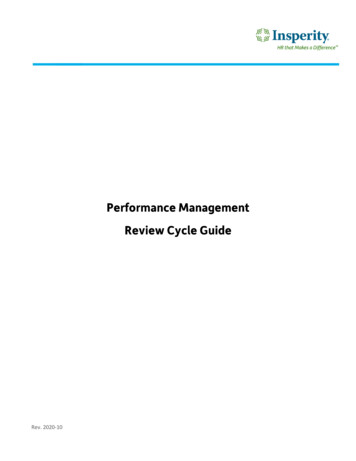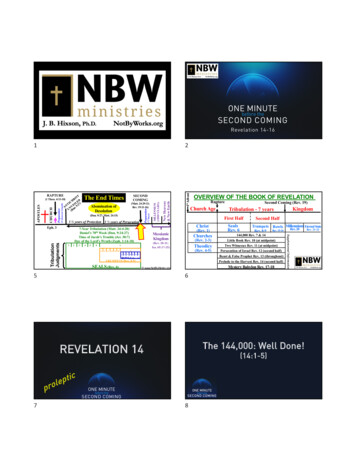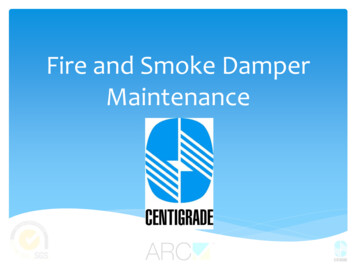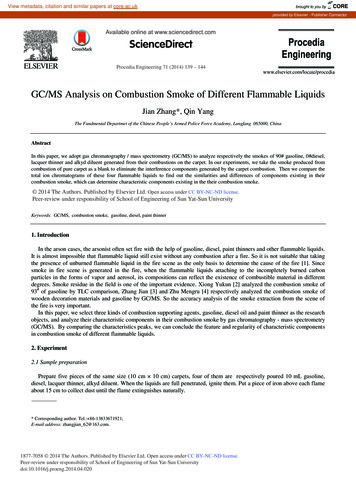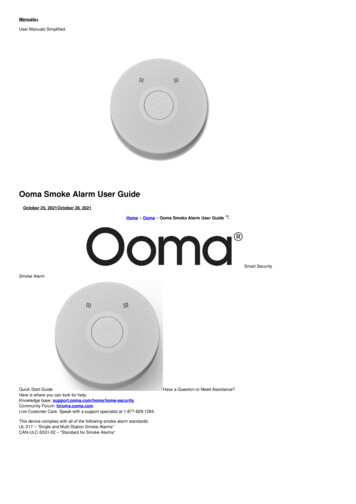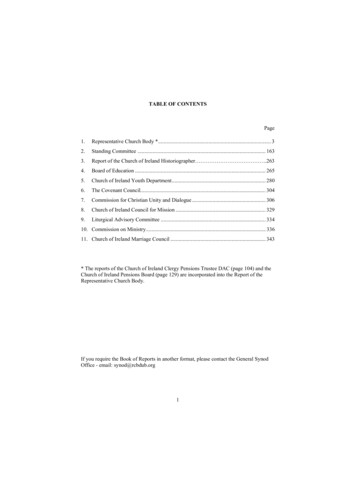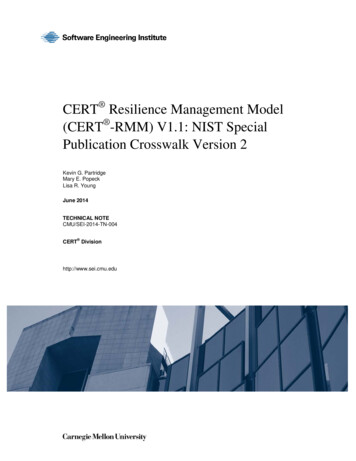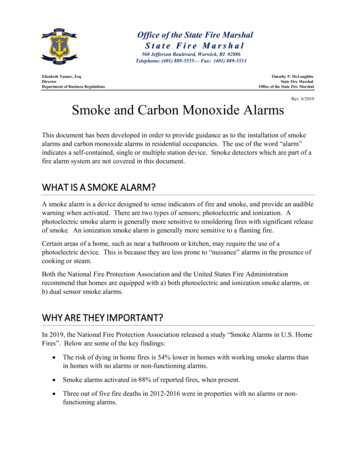
Transcription
Office of the State Fire MarshalState Fire Marshal560 Jefferson Boulevard, Warwick, RI 02886Telephone: (401) 889-5555— Fax: (401) 889-5533Elizabeth Tanner, EsqDirectorDepartment of Business RegulationsTimothy P. McLaughlinState Fire MarshalOffice of the State Fire MarshalSmoke and Carbon Monoxide AlarmsRev. 8/2019This document has been developed in order to provide guidance as to the installation of smokealarms and carbon monoxide alarms in residential occupancies. The use of the word “alarm”indicates a self-contained, single or multiple station device. Smoke detectors which are part of afire alarm system are not covered in this document.WHAT IS A SMOKE ALARM?A smoke alarm is a device designed to sense indicators of fire and smoke, and provide an audiblewarning when activated. There are two types of sensors; photoelectric and ionization. Aphotoelectric smoke alarm is generally more sensitive to smoldering fires with significant releaseof smoke. An ionization smoke alarm is generally more sensitive to a flaming fire.Certain areas of a home, such as near a bathroom or kitchen, may require the use of aphotoelectric device. This is because they are less prone to “nuisance” alarms in the presence ofcooking or steam.Both the National Fire Protection Association and the United States Fire Administrationrecommend that homes are equipped with a) both photoelectric and ionization smoke alarms, orb) dual sensor smoke alarms.WHY ARE THEY IMPORTANT?In 2019, the National Fire Protection Association released a study “Smoke Alarms in U.S. HomeFires”. Below are some of the key findings: The risk of dying in home fires is 54% lower in homes with working smoke alarms thanin homes with no alarms or non-functioning alarms. Smoke alarms activated in 88% of reported fires, when present. Three out of five fire deaths in 2012-2016 were in properties with no alarms or nonfunctioning alarms.
WHOSE RESPONSIBILITY ARE SMOKE AND CARBON MONOXIDEALARMS?The owner of a house is responsible for installing and maintaining operational smoke and carbonmonoxide alarms. In a rental situation, unless specified in the lease, the responsibility remainsthat of the landlord.A property owner must make operable, within seven (7) days after being notified by certifiedmail by the occupant and/or enforcement official, any inoperable alarms.If the owner fails to make the alarms operable within the allowed timeframe, the tenant maymake the alarm operable if the total reasonable cost of repairs does not exceed fifty dollars( 50.00). The tenant may then deduct the actual reasonable cost of repairs from his or her rent,not to exceed fifty dollars ( 50.00).TRANSFER OF TITLE INSPECTIONSAt the time of the transfer of title on a property, the seller must provide the purchaser with acertificate stating that the smoke and carbon monoxide alarms have been inspected within onehundred twenty (120) days prior to the date of sale. Inspections shall be done by the local firedepartment or the Office of the State Fire Marshal.A fee of thirty dollars ( 30.00) shall be collected for the inspection and be the responsibility ofthe seller. A fee of sixty dollars ( 60.00) shall be collected for any re-inspection due to improperinstallation, wrong location, improper wiring or failure to appear to a mutually agreed uponappointment.Refer to the below guidelines in this document for proper installation specifications.INSTALLATION GUIDELINES FOR ONE & TWO-FAMILY DWELLINGSThe installation requirements of smoke and carbon monoxide alarms are specific to the year ahouse was built. For more information, refer to the Rhode Island Fire Safety Code.
Homes built in 1976 or prior: Smoke alarms shall be installed outside sleeping areas and on each level (includingbasements) Carbon monoxide alarms shall be installed outside sleeping areas Devices may be battery operated and are not required to be interconnected Devices may be combination smoke and carbon monoxide unitsHomes built on January 1st, 1977 through December 21st, 2001: Smoke alarms shall be installed outside sleeping areas and on each level (includingbasements) Carbon monoxide alarms shall be installed outside sleeping areas Smoke alarms shall be hard-wired with battery back-up and interconnected CO detectors may be battery operated and are not required to be interconnected Devices may be combination smoke and carbon monoxide unitsHomes built on January 1st, 2002 through February 19th, 2004: Smoke alarms shall be installed outside sleeping areas and on each level (includingbasements) Carbon monoxide alarms shall be installed outside sleeping areas Devices shall be hard-wired with battery back-up and interconnected Devices may be combination smoke and carbon monoxide unitsHomes built on February 20th, 2004 through December 31st, 2012: Smoke alarms shall be installed inside each bedroom and on each level (includingbasements) Carbon monoxide alarms shall be installed outside sleeping areas and on each level(including basements) Devices shall be hard-wired with battery back-up and interconnected
Devices may be combination smoke and carbon monoxide unitsHomes built on January 1st, 2013 to present: Smoke alarms shall be installed in all sleeping rooms, outside all sleeping areas and oneach level (including basements) Carbon monoxide alarms shall be installed outside sleeping areas and on each level(including basements) Devices shall be hard-wired with battery back-up and interconnected Devices may be combination smoke and carbon monoxide unitsINSTALLATION GUIDELINES FOR THREE-FAMILY DWELLINGS Smoke alarms shall be installed inside all sleeping rooms, outside all sleeping areas andon each level (including basements) Smoke alarms shall also be located on each floor landing of common stairways, incommon corridors and common basements (unless equipped with automatic sprinklersystem) Carbon monoxide alarms shall be installed outside sleeping areas and on each level(including basements, excluding attics) IF dwelling unit contains fuel-burning appliances,fireplaces or attached garage. Devices shall be hard-wired with battery back-up and interconnected. Dwelling areasand common areas will not be interconnected with one another. Devices may be combination smoke and carbon monoxide unitsA local, supervised fire alarm system shall be permitted in place of smoke alarms. Each systemshall be installed as per code.
INSTALLATION GUIDELINES FOR APARTMENTS, TOWNHOUSESAND CONDOMINIUMS Each dwelling unit shall comply with the applicable requirements of one and two-familydwellings Every building having between four and seven units shall be required to have a local firealarm system Every building having more than seven units shall be required to have a municipallyconnected fire alarm system.Exception: Buildings that have units with suitable fire resistance separation may be exempt from firealarm system requirements. Buildings that have central heating plants that do not transfer heat via ductwork, and thathave suitable separation from the rest of the building, and where dwelling units do nothave any other fuel burning appliances, fireplaces or attached or integral garages, may beexempt from carbon monoxide requirements.PLACEMENT OF SMOKE AND CARBON MONOXIDE ALARMSAnywhere on the ceiling.12 inches from the top of the detector to the ceiling.Within 36 inches of the peak or high side of the slope, butno closer than 4 inches vertically or from an adjoining wallsurface. Ceiling mounted:Wall mounted:Peaked or sloped ceilings: Devices shall not be installed within 36 inches of heating or cooling registers, the tip of aceiling paddle fan, a kitchen door or a bathroom door containing a tub or shower. Devices within a 20-foot horizontal path of a cooking appliance shall be equipped with analarm-silencing means or be of the photo-electric type.
Where stairs lead to other occupied levels, a smoke alarm or smoke detector shall belocated so that smoke rising in the stairway cannot be pre-vented from reaching thesmoke alarm or smoke detector by an intervening door or obstruction. For stairways leading up from a basement smoke alarms or smoke detectors shall belocated on the basement ceiling within 2 feet of the entry to the stairs. Smoke alarms should be placed near the first bedroom door in a hallway closest to theliving area. All devices shall be installed per manufacturer’s recommendations. Check with your local Fire Marshal for a list of approved wireless interconnectedsystems.MAINTENANCE AND TESTING OF ALARMSIt is the responsibility of the property owner to maintain all alarms installed in the building.Alarms that are not required by code should be maintained or removed. At minimum, thefollowing maintenance guidelines should be adhered to: Test all alarms at least monthly Replace all batteries at least yearly (unless “long-life” or lithium batteries) Smoke alarms must be replaced ten (10) years from the date of manufacture unlessotherwise specified by the manufacturer Carbon monoxide alarms must be replaced seven (7) years from the date of manufactureunless otherwise specified by the manufacturer.FOR MORE INFORMATIONContact your local fire department or the Office of the State Fire Marshal for more information.Rhode Island Office of the State Fire Marshal560 Jefferson Blvd, Warwick RI 02886main: (401) 889-5555 fax: (401) 889-5533http://fire-marshal.ri.gov
The use of the word "alarm" indicates a self-contained, single or multiple station device. Smoke detectors which are part of a fire alarm system are not covered in this document. WHAT IS A SMOKE ALARM? A smoke alarm is a device desig ned to sense indicators of fire and smoke, and provide an audible warning when activated.
